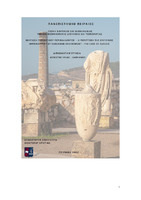Bελτίωση περιαστικού περιβάλλοντος - Η περίπτωση της Ελευσίνας
Improvement of the suburban environment - The case of Eleusis

Προβολή/
Λέξεις κλειδιά
Περιβάλλον ; Ελευσίνα ; WTA ; WTP ; CVMΠερίληψη
Η Ελευσίνα βρίσκεται σε μια προνομιακή γεωγραφικά θέση που ευνόησε την ανάπτυξη σημαντικών οικισμών από την αρχαιότητα μέχρι σήμερα. Στην αρχαιότητα ήταν γνωστή για το Ιερό της Δήμητρας και τα «Ελευσίνια Μυστήρια» και στη σύγχρονη εποχή για τη βιομηχανική ανάπτυξη των αρχών του 20ου αι. Ακριβώς αυτή η βιομηχανική ανάπτυξη προκάλεσε μια σειρά περιβαλλοντικών προβλημάτων και υποβάθμισε στην ποιότητα ζωής των κατοίκων της.
Η παρούσα εργασία καταγράφει τη πορεία της δημιουργίας των βιομηχανιών κατά μήκος του παραλιακού μετώπου της πόλης, τις μετρήσεις των ατμοσφαιρικών ρύπων, το προφίλ των κατοίκων και τα αιτήματά τους για βελτίωση. Στην έρευνα εφαρμόστηκε η μέθοδος (CVM – Μέθοδος Υποθετικής Αξιολόγησης) που αποτελεί κατάλληλο εργαλείο στην αποτίμηση αγαθών για βελτίωση του περιβάλλοντος καθώς οι κλασικές μέθοδοι αποτίμησης λειτουργούν σε εμπορεύσιμα αγαθά και δεν είναι κατάλληλες για τα μη εμπορεύσιμα καθώς η αρχή προσφοράς -ζήτησης δεν ισχύει και η ποικιλομορφία και η αφηρημένη φύση των περιβαλλοντικών αγαθών δυσχεραίνει κάθε προσπάθεια ποσοτικοποίησης οποιασδήποτε ιδιότητάς τους.
Βασικό εργαλείο ήταν ένα ερωτηματολόγιο που σχεδιάστηκε και μελετήθηκε ώστε να περιέχει δημογραφικά στοιχεία, σχέσεις με την πόλη της Ελευσίνας και αποδοχή ή απόρριψη της πόλης, ύπαρξη ή όχι περιβαλλοντικής συνείδησης και διαχείρισης για να καταλήξει στις ερωτήσεις WTP και WTA.
Η μεθοδολογία του CVM περιλαμβάνει 2 παραμέτρους. Η πρώτη παράμετρος Willingness To Pay’ (WTP, προθυμία πληρωμής) δείχνει την προθυμία των ερωτηθέντων να πληρώσουν για να αποκτήσουν ένα βελτιωμένο περιαστικό περιβάλλον, ενώ η παράμετρος ‘Willing to Accept’ (WTA, προθυμία αποδοχής), δηλώνει το ποσό το οποίο επιθυμούν να λάβουν οι ερωτώμενοι ώστε να απωλέσουν το περιβαλλοντικό αγαθό, δηλ., να μην γίνει καμία παρέμβαση περιβαλλοντικής προστασίας και αποκατάστασης στην πόλη.
Οι απαντήσεις έδειξαν ότι οι 179 από τους 250 ερωτηθέντες δεν είναι διατεθειμένοι να δώσουν χρήματα εκτός αυτών που ήδη πληρώνουν (φορολογία, δημοτικά τέλη). Αντιθέτως 45 από τους 250 είναι διατεθειμένοι να λάβουν ένα ποσό εφάπαξ ως αποζημίωση έτσι ώστε να μην γίνουν παρεμβάσεις. Στη συνέχεια καταγράφηκαν τα προτερήματα και τα προβλήματα της συγκεκριμένης μεθόδου. Στα προτερήματα αναφέρεται η δυνατότητα αξιόπιστης καταγραφής του κοινωνικοοικονομικού χαρακτήρα της περιοχής, ενώ στα προβλήματα κυριαρχεί η δυσκολία κοστολόγησης της αναβάθμισης του περιβάλλοντος είτε κάποιος πρέπει να πληρώσει είτε να πληρωθεί. Ενώ δηλ. οι απαντήσεις στις ερωτήσεις WTP και WTA δεν απέδωσαν σαφή εικόνα, ένα δείγμα 23 ατόμων εξέφρασε πολύ συγκεκριμένες προτάσεις για τη βελτίωση του περιαστικού περιβάλλοντος της Ελευσίνας. Σε κάθε περίπτωση, η Μέθοδος Υποθετικής Αξιολόγησης είναι ένα χρήσιμο εργαλείο αξιολόγησης στην αποτίμηση των περιβαλλοντικών αγαθών, ιδιαιτέρως στην αξία που προσδίδει η κοινωνία στο αγαθό αυτό. Σε δεύτερο επίπεδο, μπορούν να εξαχθούν χρήσιμα συμπεράσματα σχετικά με τα προγράμματα ανάπτυξης αστικού και περιαστικού περιβάλλοντος τα οποία πρέπει να υλοποιηθούν.


